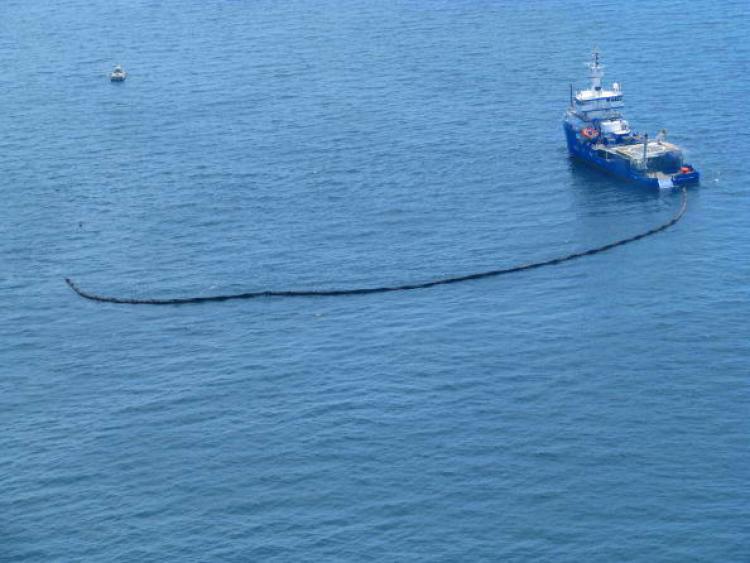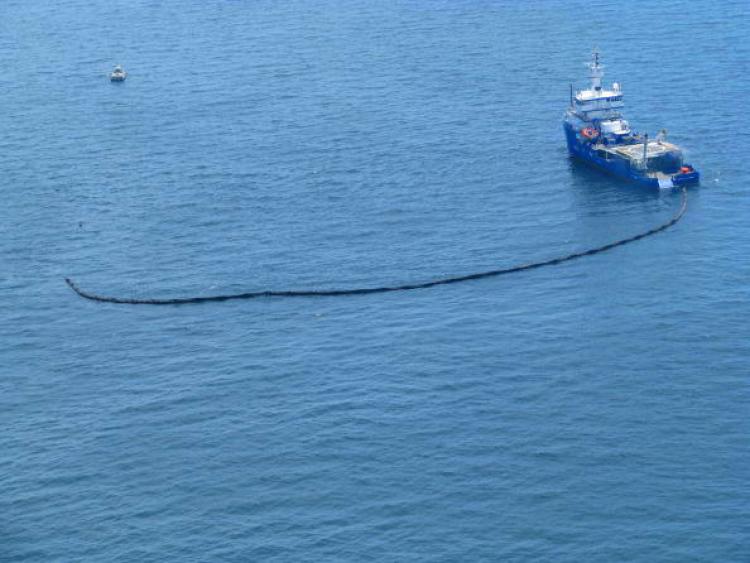The oil spill from a sunken British Petroleum (BP)-contracted oil rig is continuing to leak an estimated 1,000 barrels of oil a day at the Gulf of Mexico sea bottom. The spill, which is likely damaging underwater wildlife and alarming surrounding areas, could end up costing BP millions of dollars for the 2010 business year.
The Transocean-operated oil rig Deepwater Horizon was drilling for BP off the Louisiana coast when it initially caught fire and then sank into the ocean on April 22. After sinking, it began to leak oil profusely from two different locations more than 100 feet underwater.
Weather conditions that were hindering the initial efforts to slow down the flow of oil improved Wednesday. BP workers appeared confident that they could put a stop to the leak, which is in the best interest of the company, considering a barrel of oil currently costs close to $77.
“The safety of the people working offshore is our top priority and the improved weather has created better conditions for our response. This, combined with the light, thin oil we are dealing with has further increased our confidence that we can tackle this spill offshore,” said BP Group Chief Executive Tony Hayward in a press release.
The oil spill is registering on the surface of the water with no confirmed reports of what is happening to the wildlife underneath. Air photos from the scene reveal a startling black line on the water where tens of thousands of gallons of oil have risen to the surface. The spill has now reached an estimated 1,800 square miles, reported the San Francisco Chronicle.
The oil spill was originally reported as being over 150 miles from the coast of Louisiana, but now so much oil has spilled into the ocean that it is only 36 miles away from the coast.
Transocean reported most recently that the rig was insured for such an accident, but it is yet to be seen whether all of the ongoing clean-up costs will be covered.
“The Deepwater Horizon is insured for total loss coverage and for wreck removal, to the extent removal can be carried out and is required. The total insured value of the rig is $560 million,” read Transocean’s statement.
A $100 million drilling effort has been announced by BP to lessen the flow of oil to the two points leaking over 40,000 gallons of oil a day into the ocean. The relief drilling will commence on Thursday, following failed attempts to locate the shut-off valves by the workers in small submarines, reported the Associated Press.
Nine Transocean workers along with two workers from another company are still missing. There has been no official report on what lead to the fire. With the rig underwater and full of oil, facts regarding the cause are likely to take a while.
Government officials and wildlife organizations are on watch in Mississippi, Alabama, and Florida due to the constant spreading of the oil slick. No estimates have been established to determine when the leaking oil lines could be stopped. The only hope for now is for the planned relief drilling to lessen the leak on Thursday.
The Transocean-operated oil rig Deepwater Horizon was drilling for BP off the Louisiana coast when it initially caught fire and then sank into the ocean on April 22. After sinking, it began to leak oil profusely from two different locations more than 100 feet underwater.
Weather conditions that were hindering the initial efforts to slow down the flow of oil improved Wednesday. BP workers appeared confident that they could put a stop to the leak, which is in the best interest of the company, considering a barrel of oil currently costs close to $77.
“The safety of the people working offshore is our top priority and the improved weather has created better conditions for our response. This, combined with the light, thin oil we are dealing with has further increased our confidence that we can tackle this spill offshore,” said BP Group Chief Executive Tony Hayward in a press release.
The oil spill is registering on the surface of the water with no confirmed reports of what is happening to the wildlife underneath. Air photos from the scene reveal a startling black line on the water where tens of thousands of gallons of oil have risen to the surface. The spill has now reached an estimated 1,800 square miles, reported the San Francisco Chronicle.
The oil spill was originally reported as being over 150 miles from the coast of Louisiana, but now so much oil has spilled into the ocean that it is only 36 miles away from the coast.
Transocean reported most recently that the rig was insured for such an accident, but it is yet to be seen whether all of the ongoing clean-up costs will be covered.
“The Deepwater Horizon is insured for total loss coverage and for wreck removal, to the extent removal can be carried out and is required. The total insured value of the rig is $560 million,” read Transocean’s statement.
A $100 million drilling effort has been announced by BP to lessen the flow of oil to the two points leaking over 40,000 gallons of oil a day into the ocean. The relief drilling will commence on Thursday, following failed attempts to locate the shut-off valves by the workers in small submarines, reported the Associated Press.
Nine Transocean workers along with two workers from another company are still missing. There has been no official report on what lead to the fire. With the rig underwater and full of oil, facts regarding the cause are likely to take a while.
Government officials and wildlife organizations are on watch in Mississippi, Alabama, and Florida due to the constant spreading of the oil slick. No estimates have been established to determine when the leaking oil lines could be stopped. The only hope for now is for the planned relief drilling to lessen the leak on Thursday.





